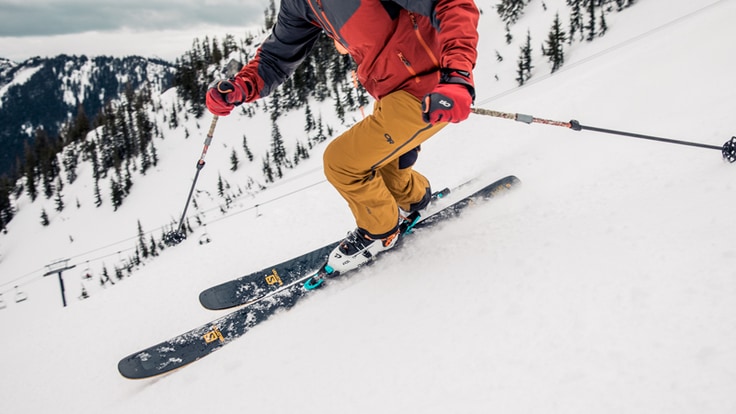You don't want to call it quits early on your first day out skiing because your sore thighs and legs are screaming for après ski just a few runs in. A preseason ski conditioning workout can help you ski better, stay out longer and have more fun.
The plan strengthens lower-body muscles (quads, hamstrings, glutes) that you use most when skiing. It also aims to improve your mobility and balance to help you control your skis better and support areas, such as your knees, that are more prone to skiing injuries.
Here's a quick, general overview of how to train for skiing:
- Boost muscle power. Strengthen the areas that get worked the most: your quads, glutes, hamstrings and hips.
- Focus on balance. Work your core and the muscles around your hips, which in turn helps provide stability to injury-prone areas such as the knees.
- Build endurance. Condition your body so you can easily ski run after run without packing it in before you're ready.
- Bump up your cardio. Complement this exercise plan with cardio activity such as running, biking or interval training to get your lungs and heart pumping.
Before beginning any training plan, check in with your doctor or certified training professional.
Training Schedule for Skiing
- When to start: Start these exercises about six to eight weeks before the ski season starts. It takes about that amount of time for you to feel the benefits in terms of better performance.
- How often? Do these exercises two or three times a week.
- Boost your cardio: In addition to these exercises, you'll want to increase your overall fitness level with a cardio workout to get your heart rate up and work your lungs. Pick an activity that you enjoy doing, whether it's running, biking, jumping jacks or high-intensity interval training (HITT). Your goal should be 30 minutes of cardio activity two to three times a week to get your heart and lungs prepped for those bursts downhill.
Training Exercises for Skiing
Keep the following in mind as you train:
- Make the exercises fit your body, not the other way around.
- If something hurts, modify the exercise or skip it.
- Move at your own pace. Increase the number of sets or add more resistance or weight as your training progresses.
Warm up:
Start your workout with five to 10 minutes of easy cardio activity. This could be a short session on a treadmill, jumping jacks or jogging. Then follow these guidelines as you progress through the exercises in this article:
- Inhale during initial exertion, then exhale as you return to the starting position. Make sure you breathe regularly during faster exercises.
- Rest for 30 to 45 seconds at the end of each exercise (unless otherwise noted).
- Do the full set of exercises. Rest for two minutes and then repeat the full set at least once more. If you're able, do a third set of exercises.
Walking Lunge with Rotation Exercise
This exercise works your glutes, quads, hamstrings and abdominals, and improves your core rotation.
Prop: None
- Stand with your feet slightly apart.
- Step one foot forward into a lunge. Your back knee should drop at a 90-degree angle to the ground. Your forward knee should also be at a 90-degree angle.
- As you step forward, rotate your body to the side in the direction of your lead knee. Have arms at chest height, slightly elevated from your sides.
- Drive up and through your forward leg to take the next lunge step. Your back knee should now be out front.
- Repeat 10 times each side for a total of 20.
Tips and modifications: If you don't have enough space, you can stay in one spot and alternate your legs. Make it easier by keeping your back leg straight. Make sure that your knees do not go inward and stay in a straight line with your foot and hip.
Hip Roll Exercise
There's a direct relationship between hip strength and control of your knees. When your hip strength is weak, your knees tend to dive inward. This exercise strengthens the muscles of your hips, including the glutes, to help prevent knee pain.
Prop: Chair, if needed for balance.
- Stand on your left leg.
- Lean your body forward at your hips, keeping back straight and lift your right leg back behind you, slightly off the ground.
- Rotate (roll) your hip away from your standing foot.
- Keep your body in a straight plane as you roll your hips back.
- Repeat 10-15 times on each side.
Tips and modifications: If it's too hard to balance, hold on to the back of a chair or keep your toes on the ground.
Squat Reverse Lunge Exercise
These exercises get you into your ski stance and work your quads, glutes and hamstrings so you have stronger legs.
Prop: None
- Stand with your feet shoulder-width apart.
- Squat like you're sitting back into a chair.
- Stand up and step one leg back into a reverse lunge. Your knees should be at a 90-degree angle to the floor. Do not let your knees go inward; keep them in line with your feet.
- Return to the squat position and repeat on the other leg.
- Do 10 reps on each leg.
Tips and modifications: Avoid arching your back. To modify the exercise, you can touch your foot back rather than going all the way into a deep lunge.
Lateral Ski Jump Exercise
Like the previous exercises, this also works your guads, glutes and hamstrings. These power exercises prep you for those explosive ski movements and energy bursts you'll need to control your descent down the mountain.
Prop: None
- Stand with your feet hip-width apart and knees slightly bent, balancing on one leg.
- Jump to the side, landing on the other leg. Think about landing softly with your knee slightly bent.
- Then jump to the other side, landing on the other leg.
- Swing your arms sideways across your body like a speed skater.
- Repeat 15 on each side for a total of 30.
Tips and modifications: If you find this exercise too challenging, make smaller jumps to the side, move slower or touch your toe to the ground rather than keeping it off the floor.
Chop Exercise
This exercise will strengthen your core and help prevent lower back pain. It will also help you build up core strength so you can initiate turns from your core rather than your arms or shoulders.
Prop: Resistance band
- Use a resistance band that you can secure slightly above shoulder height.
- Stand sideways to where the band is anchored and position yourself so that you can reach up even with your shoulder to grab the free end of the band with both hands; your knees should be slightly bent.
- Pull the band down across your body while turning your body. Think about the trunk doing the majority of the work for this exercise instead of your arms and shoulders.
- Keep your arms as straight as you can as you pull down on the band; your arms should act as guides, with your obliques and back muscles generating the pulling and rotating power.
- Do this 15 times; then repeat facing the other way.
- Rest for 90 seconds before moving on to the next exercise.
Tips and modifications: Adjust band resistance level by shortening it to increase resistance or lengthening it to ease the resistance. Your goal is to feel fatigued at the end of your reps, but not so fatigued that you struggle to finish them.
Lift Exercise
This exercise works on your rotation and targets your core and obliques (the sides of your abdominals). A strong core helps you stay balanced while skiing. You're building power and strength in your glutes, quads and calves as you move with the resistance band.
Prop: Resistance band
- Use a resistance band that you can secure at about ankle height.
- Stand sideways to where the band is anchored and position yourself so that when you grab the end of the band with both hands, there is tension in the band.
- Rotate your torso upward to the right, pulling the end of the band at an upward angle across the front of your torso; let your feet pivot until you are facing in the opposite direction with your arms straight in front of your body. Straighten the leg closest to where the band is anchored while pushing up onto the toe of that foot.
- Return to the starting position while maintaining an even tension in the band.
- Through this entire motion, your core muscles should be powering the movement; your shoulders should stay square and your hips should remain aligned; your elbow and wrists should also remain as straight as possible.
- Do this 20 times; then do the same on the opposite side for 20 more reps.
Tips and modifications: Adjust band resistance level by shortening it to increase resistance or lengthening it to ease the resistance. Your goal is to feel fatigued at the end of your reps, but not so fatigued that you struggle to finish them.
Bridge with Adductor Squeeze Exercise
This exercise strengthens the muscles in your inner thighs which will come in handy as you keep your skis parallel.
Prop: Rolled-up blanket, foam block or small medicine ball.
- Lie on your back with your knees bent, feet together and hands to your sides.
- Place an object such as a rolled-up blanket, foam block or a small medicine ball between your thighs.
- Squeeze the object between your thighs, and engage your glutes to lift your hips while driving down into your feet. Keep your belly button sucked to your spine and your abs engaged. Do not over-arch your back. Make sure that your hips do not dip to one side or the other.
- Lower to the ground and repeat 20 times.
Tips and modifications: To make the exercise more challenging, extend one leg straight out while lifting and lowering your hips. Do 10-15 times and then switch to the other leg.
Hip Clock Exercise
Staying balanced over your skis is key to good skiing, whether you're hitting fresh powder or groomed runs. This balance exercise will help you develop stronger hip coordination for better control of your skis, which in turn can help prevent knee injuries. This exercise strengthens your glutes and hamstrings. It prepares your body for uneven terrain and balancing on one ski.
Prop: None
- Stand with your weight balanced on your left leg and that knee slightly bent.
- Keep your back straight and weight centered over the standing knee.
- Imagine that you're at the center of a clock. Lift and extend your right leg, reaching forward toward 12 o'clock.
- Bring your leg back to the center.
- Repeat the movements toward the 3, 6, and 9 o'clock positions. As you reach for each position, stay balanced over the standing leg and don't let your hips shift side-to-side.
- Switch to the other leg and repeat; do 5 to 8 sets on each leg.
Tips and modifications: Keep your hips level and push into the ground with your standing foot for balance. Make smaller leg movements if you feel off balance.
Remember: Safety is your responsibility. No internet article or video can replace proper instruction and experience—this article is intended solely as supplemental information. Be sure you're practiced in proper techniques and safety requirements before you engage in any outdoors activity.
Related Articles
Improving your skiing technique is another key way to prevent injuries, ski more efficiently and avoid tired or sore legs. Learn more about proper skiing techniques such as:





